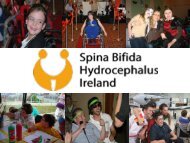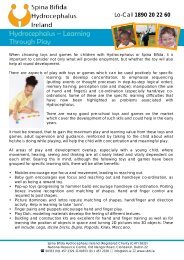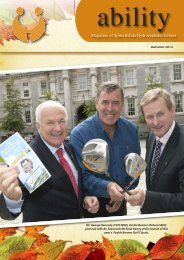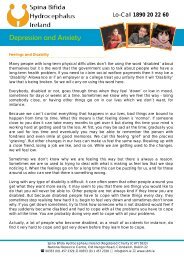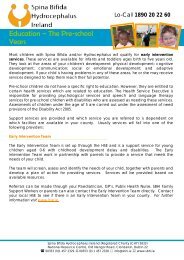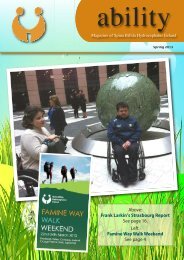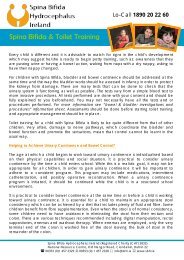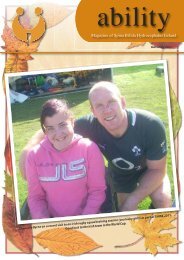(ETV)? - Spina Bifida Hydrocephalus Ireland
(ETV)? - Spina Bifida Hydrocephalus Ireland
(ETV)? - Spina Bifida Hydrocephalus Ireland
You also want an ePaper? Increase the reach of your titles
YUMPU automatically turns print PDFs into web optimized ePapers that Google loves.
What is Endoscopic Third<br />
Ventriculostomy (<strong>ETV</strong>)?<br />
Lo-Call 1890 20 22 60<br />
Endoscopic Third Ventriculostomy (<strong>ETV</strong>) is a one-time procedure; an opening is created in<br />
the floor of the third ventricle using an endoscope placed within the ventricular system<br />
through a burr hole. This allows the movement of cerebrospinal fluid (CSF) out of the<br />
blocked ventricular system and into the interpenducular cistern (a normal CSF space)<br />
thereby shortcutting any obstruction. <strong>ETV</strong> is used to treat certain forms of obstructive<br />
<strong>Hydrocephalus</strong>, such as aqueductal stenosis.<br />
The objective of this procedure is to normalise pressure on the brain without using a shunt.<br />
<strong>ETV</strong> is not a cure for <strong>Hydrocephalus</strong>, but rather an alternate treatment.<br />
Although open ventriculostomies were performed as early as 1922, they became a less<br />
common method of treating <strong>Hydrocephalus</strong> in the 1960s, with the advent of shunt systems.<br />
Despite recent advances in shunt technology and surgical techniques, however, shunts<br />
remain inadequate in many cases. Specifically, extracranial shunts are subject to<br />
complications such as blockage,<br />
infection, and over-drainage,<br />
often necessitating repeated<br />
surgical revisions. For this reason, in<br />
selected cases, a growing number<br />
of neurosurgeons are<br />
recommending endoscopic third<br />
ventriculostomy in place of<br />
shunting.<br />
The ultimate goal of <strong>ETV</strong> is to<br />
render a shunt unnecessary.<br />
Although Endoscopic Third<br />
Ventriculostomy is ideally a onetime<br />
procedure, evidence<br />
suggests that some patients will<br />
require more than one surgery to<br />
maintain adequate opening and<br />
drainage.<br />
<strong>Spina</strong> <strong>Bifida</strong> <strong>Hydrocephalus</strong> <strong>Ireland</strong> (Registered Charity (CHY) 5833)<br />
National Resource Centre, Old Nangor Road, Clondalkin, Dublin 22<br />
� 00353 (0)1 457 2329 � 00353 (0) 1 457 2328 � info@sbhi.ie � www.sbhi.ie
What is Endoscopic Third<br />
Ventriculostomy (<strong>ETV</strong>)?<br />
Who Is a Candidate for <strong>ETV</strong>?<br />
Lo-Call 1890 20 22 60<br />
Recent studies point to three factors most responsible for successful ventriculostomies:<br />
• Age (the individual should be over six months old)<br />
• The prior presence of a shunt<br />
• A diagnosis of non-communicating <strong>Hydrocephalus</strong> (obstructed ventricular<br />
pathways)<br />
New Technologies<br />
The revived interest in ventriculostomy as a viable alternative treatment approach is largely<br />
due to the development of a new technology called neuroendoscopy, or simply<br />
endoscopy. Neuroendoscopy involves passing a tiny viewing scope into the third ventricle,<br />
allowing images to be projected onto a monitor located next to the operating table. The<br />
neurosurgeon thus has a clear view of the inside of the ventricular system during surgery.<br />
How Is Success Defined?<br />
“Success” in terms of this procedure is usually considered (by patients and doctors alike) to<br />
be avoiding a shunt in a patient who would otherwise require one. Most doctors would<br />
categorise endoscopic third ventriculostomy as successful if a patient later shows clinical<br />
evidence of normal intracranial pressure (ICP) and structural evidence of stable or<br />
decreased ventricular size. If a patient was previously shunted, the shunt must be either<br />
removed or proved non-functional to demonstrate success.<br />
What Are the Potential Complications?<br />
With new technologies, such as high-resolution MRI allows doctors to clearly perceive the<br />
absence of flow through a stenosed or occluded aqueduct, while neuroendoscopic<br />
procedures offer unprecedented views from within the ventricular system.<br />
The most common complications of endoscopic third ventriculostomy are fever and<br />
bleeding. There can be an increase in CSF temperatures, sometimes causing fever due to<br />
the equipment used during this procedure. Attempts to perforate the ventricular floor can<br />
lead to bleeding, as can damage to ventricular walls or perforation of the basilar artery.<br />
Large bleeds due to vessel injury under the third ventricle may occur but they are rare.<br />
<strong>Spina</strong> <strong>Bifida</strong> <strong>Hydrocephalus</strong> <strong>Ireland</strong> (Registered Charity (CHY) 5833)<br />
National Resource Centre, Old Nangor Road, Clondalkin, Dublin 22<br />
� 00353 (0)1 457 2329 � 00353 (0) 1 457 2328 � info@sbhi.ie � www.sbhi.ie
What is Endoscopic Third<br />
Ventriculostomy (<strong>ETV</strong>)?<br />
Lo-Call 1890 20 22 60<br />
Short-term memory loss is another potential complication of endoscopic third<br />
ventriculostomy, since the procedure may affect the areas responsible for memory.<br />
However, given time, an individual usually recovers from any short-term memory loss.<br />
Because the area of the third ventricle where the opening is made is responsible for some<br />
hormonal function, there is also a possibility of sexual dysfunction this is often short-lived.<br />
Diabetes insipidus is another transient complication.<br />
Although endoscopic third ventriculostomy can ideally lead to the much-desired result of a<br />
shunt-free life, doctors caution that this procedure is not appropriate for everyone. Still, for<br />
those who meet the criteria, endoscopic third ventriculostomy offers the possibility of<br />
freedom from shunt dependency.<br />
<strong>Spina</strong> <strong>Bifida</strong> <strong>Hydrocephalus</strong> <strong>Ireland</strong> (Registered Charity (CHY) 5833)<br />
National Resource Centre, Old Nangor Road, Clondalkin, Dublin 22<br />
� 00353 (0)1 457 2329 � 00353 (0) 1 457 2328 � info@sbhi.ie � www.sbhi.ie



